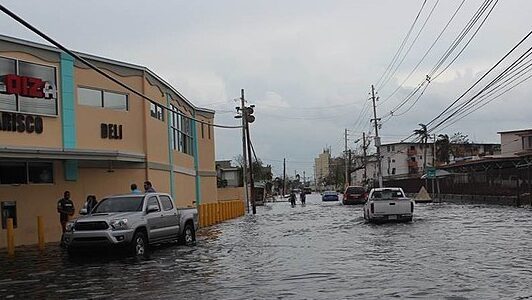
Nathalie Moreno | Oct. 5
Co-Editor-in-Chief
For 11 days, from Sept. 13 to Sept. 24, Hurricane Fiona aggressively hit Puerto Rico, a U.S. territory still recovering from the damage caused by Hurricane Maria, which struck the island in 2017.
Puerto Rico is no stranger to hurricane destruction after falling victim to the deadly currents of Hurricane Maria, a category 4 storm, just five years ago in 2017. This time, Hurricane Fiona made landfall on the island on Sunday, Sept. 18, exactly 33 years after Hurricane Hugo devastated the island, only two days before the five year anniversary of Hurricane Maria.
Maria left the island reeling with over 3,000 deaths, a damaged power grid that left millions in the dark for months and other collateral damage, some more irreparable than others. The island was still healing from one hurricane when they were struck by another.
Hurricane Fiona reached PR as a category 1 storm, but because the island is still recovering from the last hurricane, it took out the power, destroyed multiple homes and injured citizens nonetheless. Ironically, a bridge that was built in response to Maria in order to improve upon the island’s defenses against natural disasters was destroyed as well.
Two weeks after the hurricane struck, about 100,000 homes and businesses are still left powerless while an estimated 80,000 are without water. Last weekend, the number of those without power was sitting at 800,000. The rate of power restoration has been quicker than when Hurricane Maria destroyed the island’s power grid.
With clouds shadowing the entire island, storm-force winds reached up to 140 miles per hour. The amount of rainfall throughout the island varied, with some areas receiving a maximum of 12 to 20 inches and others receiving up to 30 inches of flooding. Though the hurricane was not as bad as Maria years earlier, Fiona hindered many of the rebuilding and relief efforts that were still in the works.
Every city in Puerto Rico, some worse than others, felt the wrath of Río de la Plata’s waters, with some going back into their homes and seeing dirty water stains taller than themselves.
Only four days after President Joe Biden’s declaration of emergency for Puerto Rico on Sept. 17 and on, the U.S. Department of Health and Human Services secretary Xavier Becerra declared a Public Health Emergency due to the extent of damages to the land.
“We will do all we can to assist officials in Puerto Rico with responding to the impact of Hurricane Fiona,” said Secretary Becerra in a press release by the HHS. “We are working closely with territory health authorities and our federal partners and stand ready to provide additional public health and medical support.”
In the wake of Fiona, Puerto Rico’s economy is expected to take quite a hit as well, possibly by multibillions of dollars. In efforts to ease the now-extended process of rebuilding the country, Puerto Rico’s Governor Pedro Pierluisi asked the White House on Tuesday, Sept. 2, for a waiver to the Jones Act of 1920, which mandates that all goods transported between U.S. ports only be transported on ships both owned and operated by Americans. President Biden approved the request the next day, allowing diesel to be transported into the country by non-American owned ships.
As of Friday, Sept. 30, the total death toll has increased to 25 fatalities, whether directly or indirectly related to Hurricane Fiona. 18 of those deaths were people over the age of 65.
The impact extends far beyond the borders of Puerto Rico alone—even here on Florida Southern’s campus. Members of the Hispanic/Latinx Student Coalition have felt the effects of the hurricane especially, some members family’s living in Puerto Rico.
“When I first heard about the hurricane, I felt worried for my family but at the same time I knew they would be okay,” student Gabi Lopez said. “I knew we had been through worse and had dealt with it in a calm manner so knowing that this hurricane was a lower category than [Hurricane Maria] definitely helped.”
HLSC member Jessica Valdés also commented, saying she was heartbroken to hear about the hurricane, especially for Puerto Rico, because it’s “as if they can’t catch a break.”
Both Coalition members feel as if there can always be more awareness, especially in the US.
“I feel like people try and bring out awareness as much as possible yet not much is done,” Lopez said. “A lot of people are still suffering loss from Hurricane Maria and adding this one on top of it really does not help at all.”
There are multiple foundations and non-profit organizations available to donate to Puerto Rico’s recovery.
Global Giving: https://www.globalgiving.org/projects/hurricane-fiona-relief-fund/
Hispanic Federation: https://www.hispanicfederation.org/fionahelp/







